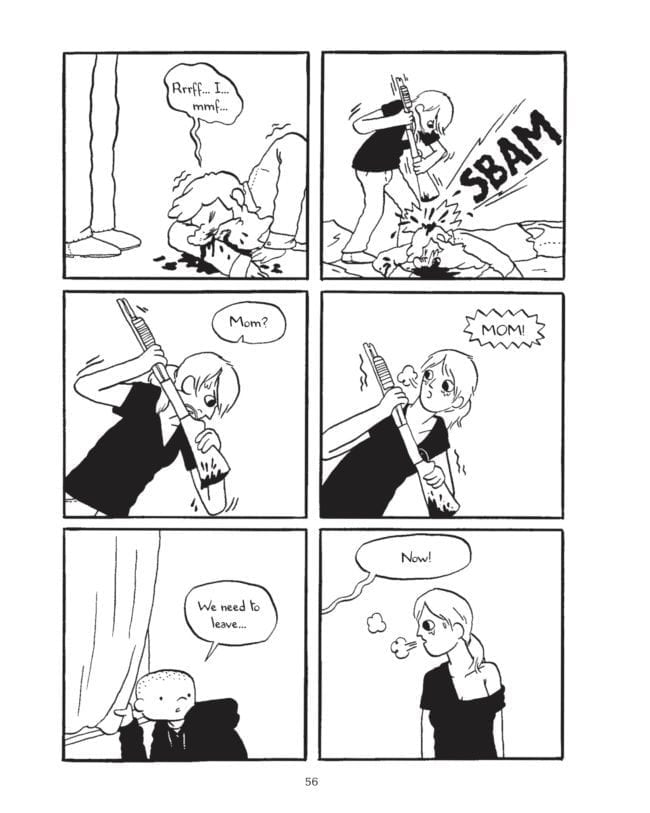Single mother May and her preteen son Eugene are part of a large and mysterious criminal organization that committed a historic heist: Fifty-two separate robberies committed at the exact same time in the exact same town, overwhelming and bewildering law enforcement as the many perpetrators made their escape with their incredible score.
That might sound like a decent premise for an exciting crime film or original graphic novel, but while Belgian cartoonist Max de Radiguès includes it in his Bastard, it’s not what he and his narrative are most concerned with. Rather, Bastard’s focus is on May and Eugene, and their complicated, layered relationship to one another, which evolves in unexpected ways throughout the short, propulsive story. And like some of the better popular crime films, there’s a big twist at the climax of Bastard, a twist of the sort that makes one immediately want to re-experience the story with this new knowledge in mind to see how obvious it was or wasn’t throughout, but, again, this has less to do with the spectacular crime and the action and violence that cascades from it than it does with the bond between this mother and son answer to Bonnie and Clyde.
When de Radiguès begins his story, May and Eugene are already on the road and on the run, a half-dozen duffle bags stuffed with cash filling their trunk. The vague particulars of their heist are related via a TV news report they overhear, in the form of an update: Suspects are starting to turn up dead, meaning that someone in the organization is murdering off their confederates, and suddenly our heroes must evade both the police and their fellow criminals. Another big set piece-like event occurs near the climax, when May rounds up a bunch of the other targets and takes the fight to their boss, and while this occurs during the story, it is just the occasional panel or so, intercut with scenes of Eugene doing more normal, mundane, crime-free things once the pair are temporarily parted.
It’s an admirable level of restraint on the artist’s part, making literature out of what could so easily be a generic genre story, partially by choosing what to show and what not to, even if what doesn’t get shown also tends to be the stuff that would likely have been the most fun to draw.
Instead, we watch the pair live their lives on the road, surviving off fast food and diners, scamming the cops and authorities, fighting off rivals and accepting help only when desperate, sometimes from a friend who turns out to be an enemy, sometimes from a stranger who turns out to be a kindly ally. While it would be wrong to call this a coming of age story for Eugene, it does chronicle a sort of end of childhood, as the idyllic but tenuous life he shares with his mom starts to come to a close, and a new chapter for them both begins.
 De Radiguès’ art, which American audience might have previously seen in Conundrum Press’ 2015 Moose, consists of realistic backgrounds slightly abstracted to leave only the most pertinent lines--not unlike his script, really--while the characters are flatter with big, open faces and an overall cartoony look to them. The female characters all have bigger, rounder eyes, with a black pupil bordered by a white eyeball, whereas all the male characters just have little black dots for eyes. This doesn’t necessarily render the male characters inscrutable or anything, and the Eugene character’s emotions are still readily expressed through his mouth and posture, but he--and all of the other male characters--aren’t nearly as expressive and communicative as May.
De Radiguès’ art, which American audience might have previously seen in Conundrum Press’ 2015 Moose, consists of realistic backgrounds slightly abstracted to leave only the most pertinent lines--not unlike his script, really--while the characters are flatter with big, open faces and an overall cartoony look to them. The female characters all have bigger, rounder eyes, with a black pupil bordered by a white eyeball, whereas all the male characters just have little black dots for eyes. This doesn’t necessarily render the male characters inscrutable or anything, and the Eugene character’s emotions are still readily expressed through his mouth and posture, but he--and all of the other male characters--aren’t nearly as expressive and communicative as May.
The result, intentional or not--the other female characters are, after all, rather minor in terms of significance and/or panel space, so it is likely just a style quirk--is that May becomes the easiest to read of all the characters, and, of the two main characters, she is obviously far easier to read than Eugene. Therefore the emotional conflicts they face play out more obviously on her face, while his small black dot eyes don’t reflect what he thinks of what they taken in nearly as clearly as hers do.
Their story is told almost entirely through their actions, which play out through only occasionally broken six-panel grids, and the substantial emotional text is mostly relegated to the look in May’s eyes as she thinks, considers, decides or resigns herself to something. As it should be, given the media. As much as Bastard--a title that serves as an oblique clue to the twist of the story--might seem to overlap with films starring criminal characters, it’s specific story that could only be told, and told in this way, in a comic book.







